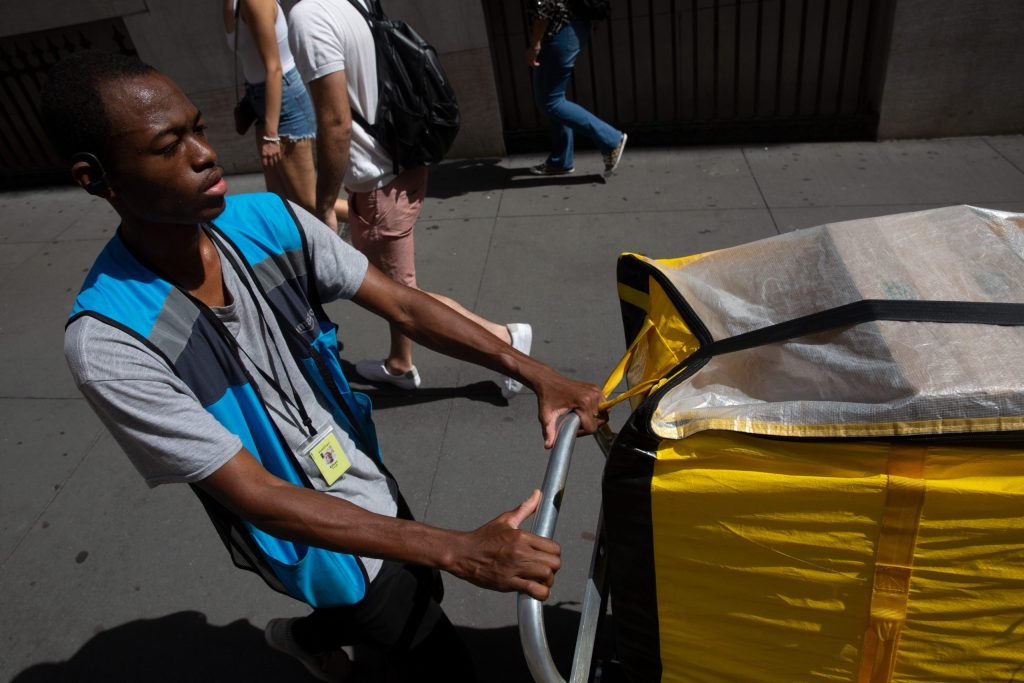The state Department of Labor on Monday issued guidance instructing employers how to protect workers from the effects of extreme heat, following reporting by THE CITY that showed workers face a higher likelihood of injuries during hot weather.
The new state guidance, part of an extreme heat resource guide, makes good on an item from Gov. Kathy Hochul’s State of the State book, which cited THE CITY’s review of two decades of Workers Compensation Board data. Our analysis found that New York City workers were 7% more likely to be injured on the job when the temperature hit 85 degrees Fahrenheit, and 8% more likely at 95 degrees.
A 2024 report by the New York State Insurance Fund found much higher rates on a statewide basis over a five-year time period, with injuries 45% more likely on days of 80 degrees or hotter.
“The New York State Department of Labor is committed to protecting all workers, especially as extreme heat events become more common,” Department of Labor Commissioner Roberta Reardon said in a statement.
Heat can stress the body, worsen heart and lung conditions, and cause sickness or even death. An average of 350 New Yorkers die each year from heat-related deaths, according to the city health department.
This summer in New York City has so far been particularly sweltering, with four heat waves on the books based on temperatures recorded in Central Park, said National Weather Service Meteorologist Brian Ciemnecki. June and July saw temperatures over 2 and 3 degrees hotter than what’s typical, he added.
Cool Reception for Mandates
The guidance outlines four steps employers “should take” to protect their outdoor workers, including providing them with adequate hydration, paid rest time, and certain types of clothing and sunscreen. The state also recommends measures to train workers and supervisors before heat exposures, as well as creating plans to help workers get used to hot weather and to respond to emergencies.
Still, the guidance falls short of a mandate — limiting its effectiveness, argued Charlene Obernauer, executive director of New York Committee for Occupational Safety and Health.
“The issue with guidance is that it’s optional, meaning many employers will not follow because they are not required to,” she said. “We do not believe that voluntary programs are effective in reducing injuries and illnesses on the job, and hope that the governor will support mandatory, enforceable standards for New York’s workers.”
California, Colorado, Maryland, Minnesota, Nevada, Oregon and Washington have enforceable heat standards in place or in development.
Proposed state-level legislation would have required New York employers to provide drinking water, rest breaks, air-conditioning and shaded rest areas to construction, agriculture, landscaping and food service workers as well as truck drivers during heat waves. The protections would kick in on 80-degree days and escalate at 90 degrees.
But the bill failed to go to a full vote by either the Senate or Assembly, after receiving pushback from groups representing schools and the agricultural industry, which both raised questions about the practicality of implementing the measure, according to memos reviewed by THE CITY.
State Sen. Jessica Ramos (D-Queens), who chairs the Senate Labor Committee and sponsored the bill, said in a statement that the new Department of Labor guidance is “a step in the right direction to protect workers in extreme temperatures.”
She added: “I am counting on this administration’s support as we look to codify these necessary worker protections and an additional enforcement mechanism into law next session.”
The guidance is not all the state is planning to do to protect workers.
As part of New York’s Extreme Heat Action Plan released in June, the Department of Labor is also working on a number of initiatives to further protect workers from heat, including inspecting for extreme heat exposure during workplace inspections and enhancing outreach around workplace rights.
Locally, New York City Emergency Management this summer ordered 2,4000 “cool down kits” along with 4,000 cooling towels and distributed them to nonprofits to give to outdoor workers, including food delivery workers.
Additional reporting by Claudia Irizzary Aponte.

